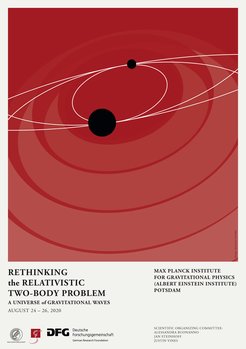Gravitational-wave astronomy and particle physics – combining the best from two worlds for future discoveries
Joint workshop begins today
Scientists want to observe and understand the universe ever more comprehensively – and with gravitational-wave astronomy, they obtained a new, powerful method. As current and future gravitational-wave detectors on the ground (Einstein Telescope and Cosmic Explorer) and in Space (LISA) become more and more sensitive, it is the right time for working on a new generation of methods for predicting gravitational-wave signals. Recently, particle physicists alongside gravitational wave scientists have begun to contribute to such efforts in novel ways. Prof Alessandra Buonanno, director at the Max Planck Institute for Gravitational Physics (Albert Einstein Institute/AEI), took a lead and invited experts from both fields to meet at the AEI August 24th – 28th 2020. Due to the constraints of COVID-19 the meeting will be held virtually.

The goal of the meeting „Rethinking the Relativistic Two-Body Problem – A universe of gravitational waves“ is to discuss how to further improve and refine gravitational-wave models. Like a fingerprint helps to identify a person, these models help to identify a gravitational-wave signal in data provided by gravitational-wave detectors. The more precise the model, the better the probability of identifying a gravitational-wave signal, and infer the properties of its astrophysical source.
In particle physics, scientists are mainly interested in scattering processes, for example when they observe how particles collide at high energies in the Large Hadron Collider (LHC). The methods used to make high-precision predictions for these processes can also be useful for gravitational-wave astronomy with current detectors, and especially with new observatories on the ground (Einstein Telescope and Cosmic Explorer) and in space (LISA), which will operate at unprecedented sensitivities.
In order to calculate gravitational waves such as those generated when black holes and neutron stars orbit and merge, the two-body problem must be solved in general relativity. The two-body problem – the calculation of the motion of two bodies interacting with each other without further external influences – is a major challenge in Einstein's world, where the very presence of matter bends space-time, and curved space-time in turn influences the motion of matter. Everything is connected to everything else. This is represented by highly nonlinear equations and the calculations become very complex. Computational methods from particle physics can help to look at the problem from a different angle and thus arrive at new insights.
